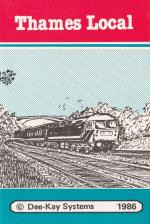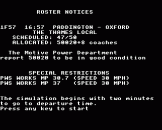Introduction
During two periods every weekday, the railway lines radiating out of London become even more congested than usual as thousands of business men are ferried to and from the busy English capital. Extra commuter trains are laid on to cope with this demand and you are to drive such a train - the 16:57 from London Paddington to Oxford, due to call at Reading and then all stations to Oxford.
Display Format
The simulation is presented as a two-part display on the television screen the upper section giving information a driver would have from visual observations and his background knowledge of the route. The lower section being a monitor of the lcomotive controls and performance. Milepost distances (mp) are given throughout in integer tenths of a mile from the buffers at Paddington.
The Route, Speed Restrictions And Signalling
From Paddington the line rises gently all the way to Reading with the exception of Southall to Slough and the approaches of Reading itself where the line levels out or even drops gently. This stretch of track is very level and fast, which has earnt its nicknames of 'Brunel's Billiard Table' and the 'Racetrack'.
From Reading the line continues to climb, although at a rate not steeper than 1 in 1320 to Didcot where the line swings around the sharp curve to head for Oxford. From here on the line follows a rough pattern of ups and downs at around 1 in 300 all the way to Oxford.
Line speeds are our approximations of the line speeds in force on this line during the summer of 1986. The maximum allowed speed at any time is displayed as part of the driver information, along with details of the next change in line speed. In addition, permanent way works will be in force, and due notice is given when approaching these slacks at Twyford (MP 30.7) and Tilehurst (MP 37).
The line is signalled with multiple aspects colour lights throughout, and as such you will encounter at least a double yellow and a yellow signal before a signal at red. As you approach all signals at caution or danger you will receive a cab warning indication (AWS) which if not acknowledged within six seconds will bring an automatic applicaction of the emergency brake.
Motive Power And Train Schedules
Although the official locomotives rostered for the job is a Class 50, a Class 47 will often suffice, the two being used interchangably. The usual loading is 8 coaches, but this may be strengthened to nine coaches depending on demand.
The schedule for the train is given in the Appendix and you will note that eight minutes recovery time is included. However, this may not be sufficient depending on line conditions.
To catch up time you may drive slightly above the line speed, but will be penalised should you travel 3mph above the line speed. Should you exceed even this by a fair margin you may be reprimanded or even sacked.
The simulation clock runs in real tiime when travelling at less than 30mph, or when approaching signals, otherwise it will run in double time.
Locomotive Controls And Driving Technique
The tractive characteristics of your locomotive are realistically reproduced in the simulation, although the controls have been somewhat simplified to the now standard D.K.S. system.
Engine power is varied by adjustment of the master controller which is calibrated between 0 (engine idling with drive disconnected) and 5 (full power). At low speeds care must be taken not to trip the generator overload trip which will be triggered should you select too high a power setting at low speed, thus producing a dangerous current, that could cause danger to the electrical equipment. Main generator failures are the main downfall of the Class 50 and sometimes to Class 47, so should you develop such a fault during your run you should continue as best as possible with reduced power.
The brake handle is similarly calibrated between 0 (off) and 5 (full on) although position 5 should only be used for emergencies, the maximum application in normal service being setting 4. You should brake with caution as your approach adverse signals, and if a signal remains at red you should bring your train to a halt within 35 yards of it in order to obtain telephone instructions from control about the situation. There are controlled signal approach sequences to all intermediate station stops, and once in the platform you should again draw up within 35 yards to the starting signal to be correctly positioned for passenger loading. To end the simulation, you should again stop your train within 35 yards of the final signal at Oxford and wait the official report on your journey.
Game Controls
| Controller: | Increase - > | |
| Decrease - < | ||
| Brakes: | Increase - X | Decreate - Z |
| WS Cancel: | Space Bar |
If you want a break during the run, the simulation can be suspended by pressing the H key (for Hold) with action restarted by pressing R.
Appendix
| MP | Location | Time | |
| 0.0 | Paddington | D | 16:57 |
| 9.0 | Southall | P | 17:06 |
| 18.6 | Slough | P | 17:12 (+2) |
| 35.9 | Reading | A | 17:27 |
| D | 17:30 | ||
| 38.7 | Tilehurst | A | 17:37 |
| D | 17:38 | ||
| 41.4 | Pangbourne | A | 17:42 |
| D | 17:43 | ||
| 44.7 | Goring and Streatley | A | 17:48 |
| D | 17:49 | ||
| 48.3 | Cholsey | A | 17:54 |
| D | 17:55 | ||
| 53.1 | Didcot | A | 18:01 |
| D | 18:02 | ||
| 55.0 | Appleford | A | 18:06 |
| D | 18:07 | ||
| 56.1 | Culham | A | 18:10 |
| D | 18:11 | ||
| 58.3 | Radley | A | 18:14 |
| D | 18:15 (+3) |
||
| 63.3 | Oxford | A | 18:25 |
Loading
*TAPE (RETURN)
PAGE=&E00 (RETURN)
CHAIN"" (RETURN)








